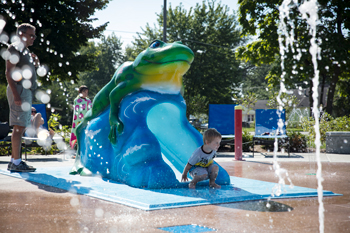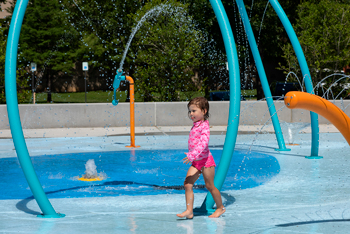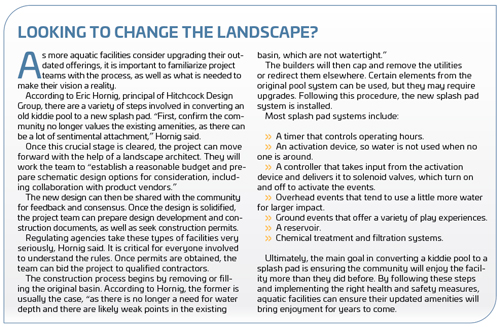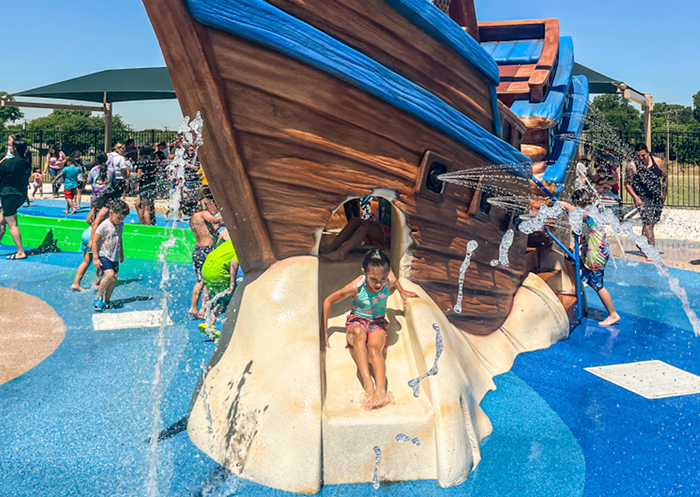By Sue Koch
Kiddie pools were popular in public parks a few decades ago and were installed for toddlers who were too small to swim in larger pools. Unfortunately, with the rise of new aquatic trends, these areas have become dead zones in many parks. Kiddie pools tend not to draw a lot of interest, as they are just stagnant bodies of water with little playability. There is not much for users to do, and they usually look old and dated. With these spaces going underutilized, parks and recreational facilities are looking for better ways to bring new interest and new patrons to aquatic play areas. As a result, converting kiddie pools to splash pads has become a popular renovation option.

Creating Inclusivity
In recent years, the aquatic play industry has made creating inclusive areas a priority for parks and aquatic facilities. Many recreation departments, homeowners associations, and community centers are replacing their kiddie pools with splash pads. These aquatic play spaces welcome users with a wide range of developmental, cognitive and physical abilities, as well as different age groups—including older generations acting as caregivers to children. This “inclusive play” has garnered even greater importance as outdoor spaces have become preferred in light of the pandemic.
Manufacturers and designers are seeing a trend in all playgrounds—whether dry or aquatic—to design an area that includes all community members, regardless of their age or abilities. Splash pads are no different, and they need to have sections that attract and encourage a wide range of patrons. Also, using a variety of water features, water flows, spacing, sizes and colors can make the facility even more accessible to its users.
The inclusive play trend coupled with the needs of a community together dictate specific requirements within a splash pad.
Generating Revenue
In general, pools tend not to be money-makers, especially for park districts. Ultimately, the more people the park attracts, the more likely it will be to break even on expenses. Since splash pads attract a larger portion of the population compared to kiddie pools, parks tend to bring in more patrons—from babies and toddlers to tweens and grandparents, and especially those with disabilities. If a facility is interested in creating a more inclusive splash pad, manufacturers can help select features and provide design and placement guidance to really make the splash play area attractive to a much larger segment of the population.

My company often helps with the design and renovation of aquatic areas, whether it is renovating or removing a kiddie pool and replacing it with a splash pad or helping an aquatic facility by adding a much larger splash pad area. We make recommendations based on space, budget and the vision for the facility. For example, we might recommend ground-level spray features when budgets are tight, as the bigger the spray feature, the higher the cost. If a facility has a smaller budget, we can help choose ground-level features, which are still fun and interactive.
A lot of facilities are not only removing their kiddie pools, but they are also increasing the footprint of their play area and adding much larger splash pads. If a facility can add a splash pad area of around 2,000 square feet, they can then fence it and open the area even before it is time for the larger pool to open. This is a huge benefit, as it extends the season for the facility and does not limit its operation based on the availability of lifeguards. Larger splash pads also bring more interest, with the pool adding new features to their facilities so more patrons can enjoy the water.
Offering Versatility
As with any community gathering space, creating a visually striking splash pad can provide excitement and interest for all users. Often, using a large, iconic water feature piece within the splash pad is important. Large buckets of water to anchor the splash pad add an element of attraction, even when the facility is not in use. Just watching the water flow—even from a distance—adds to the excitement. One of the more eye-catching options for splash pads are large rings that spray mist. These are both attractive and easily integrated into a sequencing design for inclusive play.
It is also important to remember that splash pads are more than mere water play areas. By employing strategies to enhance the overall visual aesthetics, a splash pad can lend year-round appeal to a facility, even in the winter. Some facilities add lighting to their splash pads and change the colors several times a year. For example, red and green can be used around the winter holidays.
Unlike kiddie pools, a lot of splash pad features are easy to replace using the same or existing pipes and feeds. Splash pads offer a lot of versatility, as it is fairly easy to give a splash pad a quick update with a new spray feature. In fact, interactive water features can be swapped out and updated, and play equipment like small aquatic slides can easily be added.

Streamlining Safety & Maintenance
For both kiddie pools and splash pads, maintenance procedures are pretty much the same. There might be a little more winterization in a splash pad, as there are often more pipes involved with more water features, but this is not a major difference.
In terms of water treatment, most kiddie pools are either recirculation or flow-through and when replacing the kiddie pool with a splash pad, the maintenance is the same and the system can either remain the same or can be upgraded. Recirculation of water with a water treatment system is common for splash pads. Additionally, they use a much smaller amount of water, which means less chemical treatment, which also lowers operational costs.
Splash pads are also being installed for safety reasons. Parents can feel more at ease having a smaller child play in a splash pad compared to a kiddie pool, because there is no standing water. As mentioned, they are also attractive to facilities because they do not need to be monitored by a lifeguard.
Start Splashing!
A splash pad play area can become a gathering place for people of all abilities, ages and backgrounds to relax and connect through the joy of water. Not only does the naturally inclusive landscape offer a fun adventure for a community, but adding more features also gives patrons more immersive activities and satisfies their unique physical and cognitive needs. A simple but powerful space, an inclusive aquatic facility offers a glimpse of the larger picture of universal well-being and connectivity. RM
ABOUT THE AUTHOR
Sue Koch is the owner of Products4Parks in Chicago, and a regional sales representative for Water Odyssey. Koch has more than 17 years of industry experience working with park districts, schools, landscape architects, aquatic designers and municipalities assisting with the coordination and planning of spray park design and layout, safety, construction, budgeting and after-sale support.



